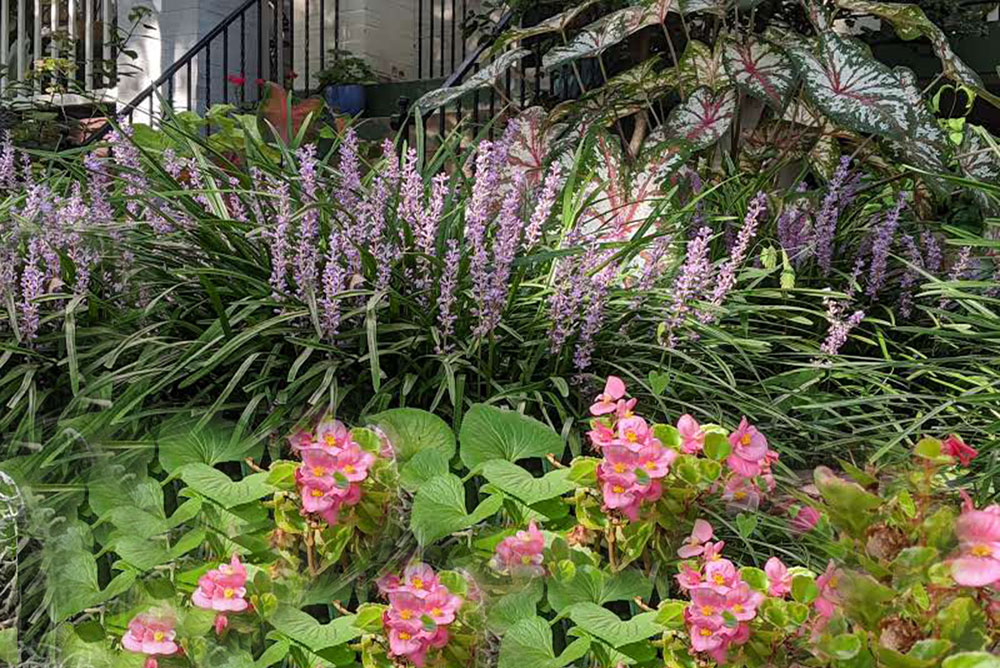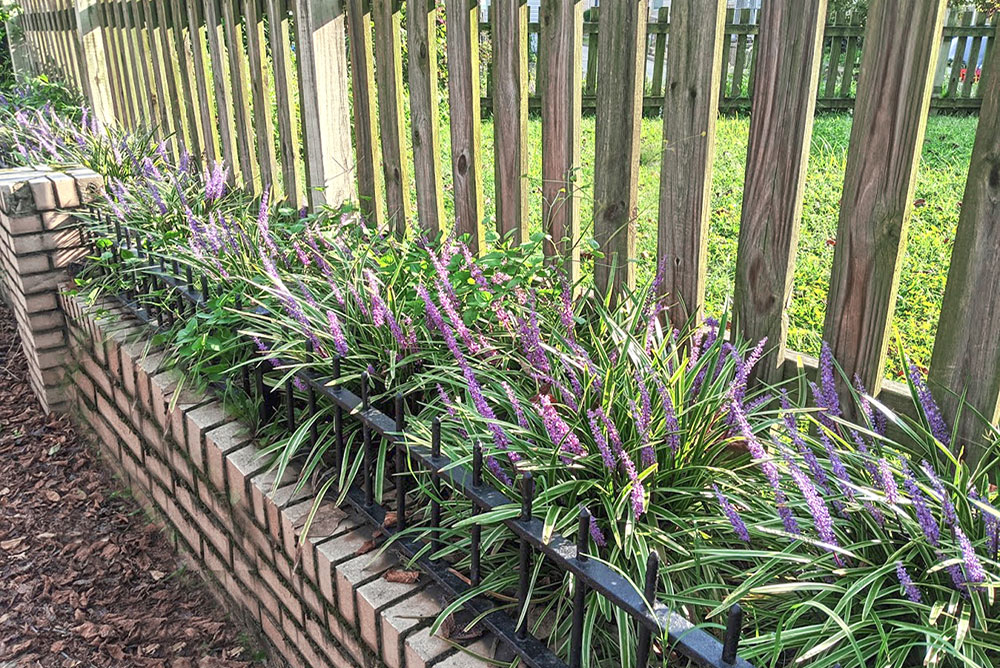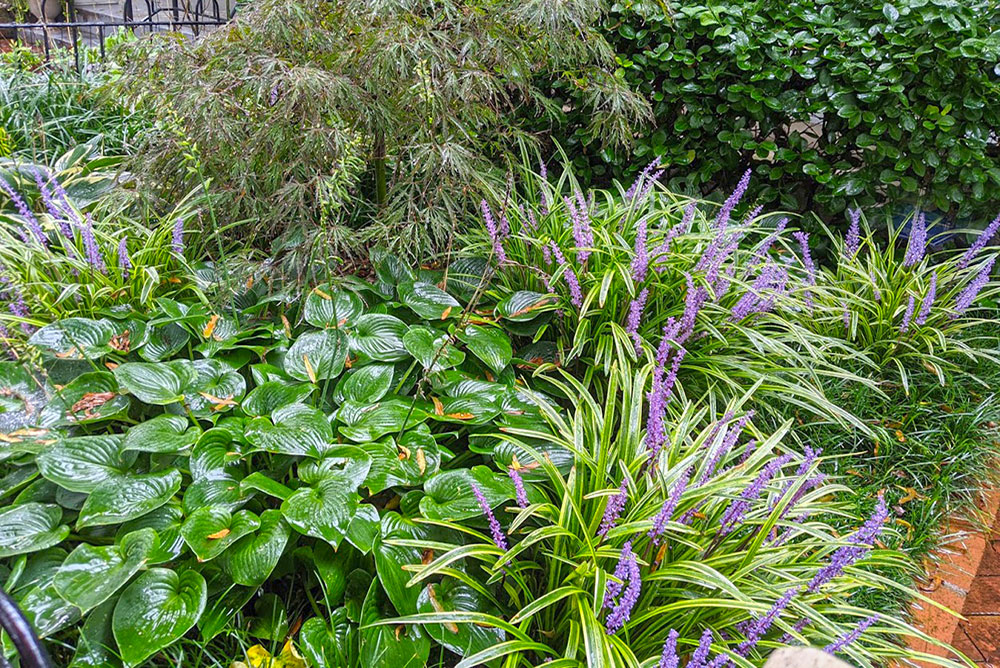
Liriope, says “Stephanie Gardens,” has escaped the confinement of the street-side tree box, where it has stood up to dogs and human feet, and is now being planted, as she says, “between the this and the that.” Here it divides the begonias from the caladium. / Photo by Stephanie Cavanaugh.
SOME YEARS AGO, it could be a decade, my friend Maggie and I were walking along Pennsylvania Avenue on a mild and lovely fall afternoon, the Capitol dome shining bright white behind us, when a young woman guided her dog over the low, looping iron railing that surrounded a freshly planted tree box and watched adoringly as her pet lifted his leg on the pansies.
Maggie said—and she’s got this wonderfully intimidating English accent so if we’re together I generally let her say things when things need to be said—”YOUNG LADY, Why are you letting your dog RUIN that planter?”

Liriope does a bang-up job as an edging, its orderly nature making it a natural for a straight line. / Photo by Stephanie Cavanaugh.
And the young lady looked up and said, and I kid you not, “There was no sign.”
As in McDonald’s having to issue a caution that their coffee is hot.
In this neighborhood, announcing “there was no sign” alternates with “this is public space,” as the excuse for all manner of unneighborly conduct.
That was the end of any attempt to plant pansies along the curb. It wasn’t just the dogs and their rude behavior; dainty flowers just don’t stand up well to the press of a foot exiting a car. The constant tramp tramp tramp schlepp in a busy corridor is ruinous.

Plays well with others: Here’s liriope as a border with hostas, plus a Japanese maple and, in the background on the right, a gardenia hedge. / Photo by Stephanie Cavanaugh.
Which leads us to liriope, pronounced leer-EYE-oh-pee. After the disastrous season of the pansies, the building owners filled every box with this curious green stuff that looked, not beautiful, but pleasant enough. This was the first I’d seen of this now-ubiquitous evergreen plant, occasionally, and incorrectly, spelled lariope, and also known as monkey grass and lily turf, though it’s akin to neither grass nor lily nor, I hope it goes without saying, monkey (see hot coffee).
Now it’s everywhere, and with good reason. Nearly indestructible, with sprightly swords of evergreen leaves and clusters of purple flowers in fall, liriope stands up to heat, cold, tromping feet and, most important, dogs. It also spreads jubilantly, quickly filling in blank and boring patches of dirt.
Most people put it in and that’s that, appreciating only its supreme utility, planting it with an air of: Okay, that works, let’s have cocktails.
Indeed, this is one of those plants that thrive on neglect and are unfussy about soil. It’s also easily divided—in fact, it must be divided annually otherwise they press up against one another in such a tight mat they lose their pleasing lightness. Ours, which started with a few plugs in the curbside garden, is dug up each year and split, so it fills box after box down the block.
Therein lies the danger. Liriope can be very boring.
So it is with pleasure I’ve noticed a certain artfulness in actual gardens this fall: The liriope has escaped the tree boxes and is being used carefully—indeed, chosen—as fine edging for borders or as a frisky filler between the this and the that. And right now, as the purple flowers wave valiantly above the green fronds, they look right pretty, an aspect heretofore overlooked, at least by me. One of few plants that come into flower in September, liriope has minor blossoms, but in a group the impact is delightful. This little workhorse deserves to be treated with more respect.
Baby, who’s coming for a visit next week with her Personal Prince Pete and their baby Wes, has a vision of liriope edging their driveway in Raleigh, North Carolina. To that end, she expects to be doing some digging and dividing.
“Ma,” she said, “liriope cost five bucks for a clump!”
To which I replied, “For you? I’ll hold a special friends and family sale and only charge $2.99.”
After all, what are mothers for?
—Stephanie Cavanaugh
LittleBird “Stephanie Gardens” just loves the green stuff. Her Green Acre column appears every Thursday—except next week, when family invades and a good time is had by all.

And what about Aunt Jeanie who lives on the ocean…would liriope survive the wind and salt water and sand blowing on to the terrace….nothing lives for very long under those conditions. Your photos are lovely….keep writing it’s always nice to learn something new from you.